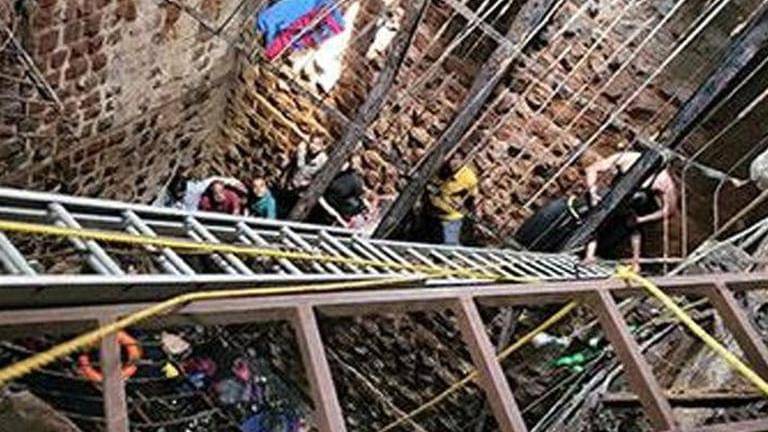- Select a language for the TTS:
- UK English Female
- UK English Male
- US English Female
- US English Male
- Australian Female
- Australian Male
- Language selected: (auto detect) - EN
Play all audios:
ABSTRACT The inheritance of _Drosophila melanogaster_ larval pupation behaviour is investigated in sixteen reciprocal crosses between field collected lines. These lines were made isogenic
for the two major autosomes enabling the data to be analyzed using contrast analysis of variance and biometrical genetic analysis. Results of both analyses showed that the trait “pupation
distance”, the distance larvae pupate from food, fits a simple additive model of inheritance with no dominance. A chromosomal analysis showed that both the second and third chromosomes act
additively on pupation distance and that the third pair of chromosomes had a much larger effect than the second. Significant variability exists in the distance _D. melanogaster_ larvae
pupate from fruit in nature. This phenotypic variation results from both heritable variation and variation from environmental sources. When the moisture content of the environment
surrounding food is modified, gene by environment interactions also contribute to variation in the phenotype. Selective pressures which may act on larval differences in pupation site choice
are discussed. SIMILAR CONTENT BEING VIEWED BY OTHERS GENETIC VARIATION OF MORPHOLOGICAL SCALING IN _DROSOPHILA MELANOGASTER_ Article 06 March 2023 SEASONAL VARIATION IN WING SIZE AND SHAPE
OF _DROSOPHILA MELANOGASTER_ REVEALS RAPID ADAPTATION TO ENVIRONMENTAL CHANGES Article Open access 26 August 2022 RAPID SEASONAL CHANGES IN PHENOTYPES IN A WILD _DROSOPHILA_ POPULATION
Article Open access 19 December 2023 ARTICLE PDF REFERENCES * Bauer, S J. 1984. Sex differences in pupation site choice in _Drosophila melanogaster_. _Dros Inf Serv_, 60, 58. Google Scholar
* Bauer, S J, and Sokolowski, M B. 1984. Larval foraging in isofemale lines of _Drosophila melanogaster_ and _D. pseudoobscura_. _J Heredity_, 75, 131–134. Article Google Scholar *
Bauer, S J, and Sokolowski, M B. 1985. A genetic analysis of path length and pupation height in a natural population of _Drosophila melanogaster_. _Can J Genet Cytol_, 27, 334–340. Article
Google Scholar * Bauer, S J, and Sokolowski, M B. 1988. Autosomal and maternal effects on pupation behaviour in _Drosophila melanogaster_. _Behav Genet_, 18, 81–97. Article CAS Google
Scholar * Casares, P, and Carracedo, M C. 1987. Pupation height in _Drosophila:_ Sex differences and influences of larval developmental time. _Behav Genet_, 17, 523–535. Article CAS
Google Scholar * Cavalli, L L. 1952. An analysis of linkage in quantitative inheritance. In Reeve, E. C. R., and Waddington, C. H. (ed.) _Quantitative Inheritanc_. London, HMSO, pp.
135–144. Google Scholar * De Belle, J S, and Sokolowski, M B. 1987. Heredity of rover/sitter: Alternative foraging strategies of _Drosophila melanogaster_. _Heredity_, 59, 73–83. Article
Google Scholar * De Souza, H, Da Cunha, A, and Dos Santos, I. 1970. Adaptive polymorphism of behavior evolved in laboratory populations of _Drosophila willistoni_. _Am Nat_, 104, 175–189.
Article Google Scholar * Godoy-Herrera, R, Cifuentes, L, Diaz De Arcaya, M F, Fernandez, M, Fuentes, M, Reyes, I, and Valderrama, C. The behaviour of _Drosophila melanogaster_ larvae
during pupation. _Anim Beh_ (in press). * Hay, D A. 1972. Genetical and maternal determinants of the activity and preening behaviour of _Drosophila melanogaster_ reared in different
environments. _Heredity_, 28, 311–336. Article CAS Google Scholar * Hays, W L. 1981. _Statistics_, 3rd ed. Holt, Rinehart and Winston, New York. Google Scholar * Markow, T A. 1979. A
survey of intra- and interspecific variation for pupation height in _Drosophila_. _Behav Genet_, 9, 209–217. Article CAS Google Scholar * Mather, K, and Jinks, J L. 1982. _Biometrical
Genetics_. Chapman and Hall, New York. Book Google Scholar * Mueller, L D, and Sweet, V F. 1986. Density-dependent natural selection in _Drosophila:_ Evolution of pupation height.
_Evolution_, 40, 1354–1356. PubMed Google Scholar * Ringo, J, and Wood, D. 1983. Pupation site selection in _Drosophila simulans_. _Behav Genet_, 13, 17–27. Article CAS Google Scholar *
Sameoto, D, and Miller, R. 1968. Selection of pupation site by _Drosophila melanogaster_ and _D. simulans_. _Ecology_, 49, 177–180. Article Google Scholar * Sokal, R, Ehrlich, P, Hunter,
P, and Schlager, G. 1960. Some factors affecting pupation site of _Drosophila_. _Ann Entom Soc Am_, 53, 174–182. Article Google Scholar * Sokolowski, M B. 1985. Ecology, genetics and
behaviour of _Drosophila_ larval foraging and pupation behaviour. _J Insect Physiol_, 31, 857–864. Article Google Scholar * Sokolowski, M B, and Hansell, R I C. 1983. Elucidating the
behavioral phenotype of _D. melanogaster_ larvae: Correlations between foraging strategies and pupation heights. _Behav Genet_, 13, 267–280. Article CAS Google Scholar * Wahlsten, D.
1979. A critique of the concepts of heritability and heredity in behavioural genetics. In Royce, J. R. and Mos, L. (ed.) _Theoretical Advances in Behavioural Genetics_, Sijthoff and
Nordhoff, Germantown, MD, pp. 425–481. Chapter Google Scholar * Wong, J L, Sokolowski, M B, and Kent, C F. 1985. Pre-pupation behaviour in _Drosophila:_ Embedding. _Behav Genet_, 15,
155–164. Article CAS Google Scholar Download references AUTHOR INFORMATION AUTHORS AND AFFILIATIONS * Department of Biology, York University, North York, M3J 1P3, Ontario, Canada Marla B
Sokolowski & Sharon J Bauer Authors * Marla B Sokolowski View author publications You can also search for this author inPubMed Google Scholar * Sharon J Bauer View author publications
You can also search for this author inPubMed Google Scholar RIGHTS AND PERMISSIONS Reprints and permissions ABOUT THIS ARTICLE CITE THIS ARTICLE Sokolowski, M., Bauer, S. Genetic analyses of
pupation distance in _Drosophila melanogaster_. _Heredity_ 62, 177–183 (1989). https://doi.org/10.1038/hdy.1989.26 Download citation * Received: 31 May 1988 * Issue Date: 01 April 1989 *
DOI: https://doi.org/10.1038/hdy.1989.26 SHARE THIS ARTICLE Anyone you share the following link with will be able to read this content: Get shareable link Sorry, a shareable link is not
currently available for this article. Copy to clipboard Provided by the Springer Nature SharedIt content-sharing initiative


